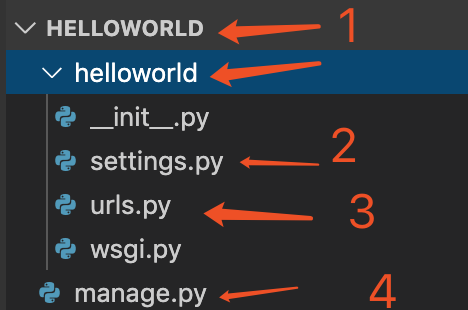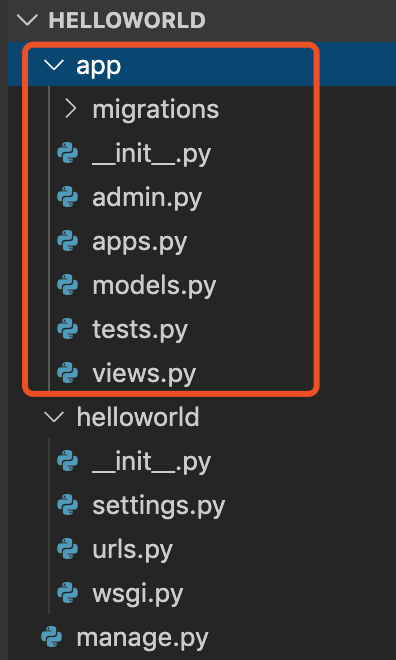Opening chapter
Through the previous article python entry practice - student management system I practiced a bunch of python syntax. This article summarizes the introduction of Django as a web framework. The premise is to have relevant web development experience (Java, php, etc.). Because this article will not involve the concept of http protocol, separation of front and back end.
Attached:
- Official course: https://docs.djangoproject.com/en/3.0/intro/tutorial02/
- Rookie tutorial: https://www.runoob.com/django/django-tutorial.html
text
My development environment
- Operating system: MacOS
- IDE: vscode
- Database: mysql
- python version 3.x
Preparation
-
Install django (for non maOS operating system, please refer to the opening tutorial to choose the installation method and verify whether the installation is successful)
python3 -m pip install django==1.11.6 -
Create project
Django admin startproject HelloWorld (this is the project name)

Four places are marked in the picture 1. After creating the helloworld project, you will find that there is another helloworld under helloworld. The helloworld mentioned later is generally the first level, which is referred to as the project root directory 2. settings.py is mainly for some configurations, such as database, static file storage location, etc 3. urls.py mainly configures the mapping relationship between URLs and functions 4. manage.py provides commands for managing projects, such as starting projects. Please pay more attention later
-
Enter project root
cd helloworld -
Launch the project and access
(it will fail to start here because of the compatibility between python3 and django. Anyway, there is a problem in the django version I use. The solution is to delete a comma of a file. If I meet it, Baidu will find out. The specific content was forgotten to save at the beginning.)
python3 manage.py runserver // You can also specify ip: host python3 manage.py runserver localhost:8080

- So far, a web project prototype has been developed
Continue to improve
At this point, we can develop our own web applications, but you may also ask
- Where is the function called by http request written and how is the mapping relationship between function and page reflected
- Location of static files
Let's talk about the new helloword project

Function and its mapping
Find a urls.py file under helloworld/helloworld /
Default configuration:
from django.conf.urls import url from django.contrib import admin urlpatterns = [ url(r'^admin/', admin.site.urls), ]
After amendment:
from django.conf.urls import url from django.contrib import admin # Here's what's new from django.shortcuts import HttpResponse, render, redirect # 1. Jump page # render means that visiting http://localhost:8000/index will jump to the index.html page def index(request): return render(request, 'index.html') # 2. Jump to the page with parameters def index02(request): return render(request, 'index.html', {'Parameter name', value}) # 3. redirection def index03(request): return redirect('/index/') # 4. Receiving parameters def index04(request): # Receive post request parameters request.POST.get('Parameter name') # Receive get request parameters request.GET.get('Parameter name') return render(request, 'index.html') # Configure url mapping urlpatterns = [ url(r'^admin/', admin.site.urls), # Configure url mapping # Visit http://localhost:8000/index / and the above index function will be called url(r'^index/', index), # TODO omits index02, index03, index 04 mapping configuration ]
- Static file storage location
Find helloworld/helloworld / there is a settings.py file below
html file configuration: about more than 50 lines
TEMPLATES = [ { 'BACKEND': 'django.template.backends.django.DjangoTemplates', # Modify this configuration item as follows # Then in the root directory of the project, create a new templates directory to store html files 'DIRS': [ os.path.join(BASE_DIR, 'templates') ], 'APP_DIRS': True, 'OPTIONS': { 'context_processors': [ 'django.template.context_processors.debug', 'django.template.context_processors.request', 'django.contrib.auth.context_processors.auth', 'django.contrib.messages.context_processors.messages', ], }, }, ]
css, js, image file configuration: at the end of the settings.py file
STATIC_URL = '/static/' # Under the project root helloworld # Of course, there's also the use of aliases. At the beginning, it's useless to talk more about them
How to reference css, js in html
<!DOCTYPE html> <html lang="en"> <head> <script src='/static/test.js'></script> <title>Document</title> </head> <body> </body> </html>
Normative items
Some of the above writing methods are mostly used for practice, so they are not standard. For example, we wrote a lot of functions in helloword/helloword/urls.py, which is very unsightly. So now introduce a new thing.
-
In the project root directory, execute
python3 manage.py startapp app (module name) #This is the second time we use the file manage.py, #The first time is to start the project. Now you can understand why this file is used #After execution, we will find that there is an app directory in the root directory of the project

-
Let django know your new app module
INSTALLED_APPS = [ 'django.contrib.admin', 'django.contrib.auth', 'django.contrib.contenttypes', 'django.contrib.sessions', 'django.contrib.messages', 'django.contrib.staticfiles', # Newly added 'app.apps.AppConfig' # You can also write 'app' directly # app is the fixed after the new directory name, # You can also open the app/apps.py file to see ] -
There is a view.py file in the app directory. We can define the function here.
from django.shortcuts import HttpResponse, render, redirect def index(request): return render(request, 'index.html') -
Then go back to helloword/helloword/urls.py file, and modify it as follows:
# 1. Import function from app.views import index # 2. configuration urlpatterns = [ url(r'^admin/', admin.site.urls), url(r'^index/', index), ]
additional
How to configure mysql database
Also find a settings.py file under helloworld/helloworld /, about 70-80 lines
Revised as follows:
DATABASES = { 'default': { 'ENGINE': 'django.db.backends.mysql', 'NAME': 'student_sys', # library 'USER': 'root', 'PASSWORD': '123456', 'HOST': 'localhost', 'PORT': 3306 } }
Then find the helloworld/app/init.py file
The file is empty by default. Add the following configuration
import pymysql # Tell django to replace mysqldb with pymysql pymysql.install_as_MySQLdb()
Introducing orm
Enter the helloworld/app / directory to find the models.py file. Modify it as follows:
from django.db import models # Define a Student class class Student(models.Model): id = models.AutoField(primary_key=True) # Primary key name = models.CharField(max_length=20) # Character type sex = models.CharField(max_length=2) birthday = models.CharField(max_length=10) def __str__(self): return self.name + "\t" + self.sex + "\t" + self.birthday
Execute in sequence under the project root directory helloworld
python3 manage.py makemigrations python3 manage.py migrate
It will automatically generate tables for us
You may also be confused:
- Why do we define a model and generate so many tables
- How to update the table structure automatically after modifying the model
- How to crud and so on
Please explore by yourself
summary
Self Tucao: in fact, such a tutorial is very tasteless, worried that the space is too long to see people dazzled.
- There is no explanation in many places, such as the configuration of settings.py, automatic table generation, etc
- There are many questions left that have not been answered, and even some questions have not been mentioned in the article. For example, 403 will appear on the visit page, how to solve them
- The reason why I didn't talk so much is that I think those problems are easy to solve
After finishing writing, I feel that the location of this article is more self summarization. Maybe you can see this article will vomit slot, spray me ~ ~ ~